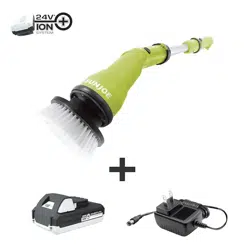Loading ...

2
• Do not allow the battery nor motor to come in contact with
water.
• In the event of an accident or breakdown, switch o the
power scrubber immediately.
SpecicSafetyWarningsfor
Cordless Power Scrubber
• Always use rubber gloves and proper eye wear to avoid
contact from splashing, soaps, or detergents on skin and/
or eyes while brush head is spinning and when brushes are
removed or attached.
• When done using power scrubber, turn the unit o while
brush is still in contact with surface to avoid getting
splashed.
• Always test on a small, inconspicuous area before using on
a larger area. Always follow manufacturer's guidelines for
cleaning and maintenence.
• Do not use with abrasive cleaners on any surface.
• Avoid exposing the power scrubber to excessive water.
If power scrubber accidentally becomes submerged in
water or water gets into battery charging compartment,
shake out liquid and allow power scrubber to dry overnight.
• Choose proper brush attachment and attach to power
scrubber as directed in assembly instructions.
• Wet the intended area and apply desired cleaning product.
• Place tip of brush on surface to be cleaned.
Electrical Safety
1. If the battery charger cord is damaged, please call the
Snow Joe
®
+ Sun Joe
®
customer service center at
1-866-SNOWJOE (1-866-766-9563).
2. If charging the power tool in a damp location is
unavoidable, use a residual current device (RCD)
protected power supply. The using of an RCD reduces the
risk of electric shock.
3. Do not abuse the charging cord. Never use the cord for
carrying, pulling or unplugging the charger.
Keep cord away from heat, oil, sharp edges or moving
parts. Damaged or entangled cords increase the risk of
electric shock.
4. Battery charger is for indoor use only. Do not charge the
power scrubber in rain, or in wet locations.
Battery & Charger
Safety Instructions
We pay a great deal of attention to the design of every battery
pack to ensure that we supply you with batteries that are safe,
durable and have a high energy density. The battery cells have
a wide range of safety devices. Each individual cell is initially
formatted and its electrical characteristic curves are recorded.
This data is then used exclusively to be able to assemble the
best possible battery packs.
Despite all the safety precautions, caution must always be
exercised when handling batteries. The following points must
be obeyed at all times to ensure safe use. Safe use can only
be guaranteed if undamaged cells are used. Incorrect handling
of the battery pack can cause cell damage.
IMPORTANT! Analyses conrm that incorrect use and poor
care of high-performance batteries are the main factors
responsible for personal and/or product damage.
mWARNING! Use only approved replacement batteries;
other batteries may damage the power tool and cause it to
malfunction, which can lead to serious personal injury.
mWARNING! Do not use a battery pack or appliance that
is damaged or modied. Damaged or modied batteries may
exhibit unpredictable behavior resulting in re, explosion or risk
of injury.
Do not modify or attempt to repair the appliance or the battery
pack except as indicated in the instructions for use and care.
Have your battery pack serviced by a qualied repair person
using only identical replacement parts. This will ensure that the
safety of the battery pack is maintained.
mCAUTION! To reduce the risk of injury, charge the
24V iON+ lithium-ion battery pack only in its designated
24V iON+ lithium-ion charger. Other types of chargers present
risk of re, personal injury and damage. Do not wire a battery
pack to a power supply plug or car cigarette lighter. Such
misuse will permanently disable or damage the battery pack.
• Avoid dangerous environments – Do not charge the
battery pack in rain, snow or in damp or wet locations.
Do not use the battery pack or charger in the presence of
explosive atmospheres (gaseous fumes, dust or ammable
materials) because sparks may be generated when inserting
or removing the battery pack, which could lead to a re.
• Charge in a well-ventilated area – Do not block the
charger vents. Keep them clear to allow for proper
ventilation. Do not allow smoking or open ames near a
charging battery pack. Vented gases may explode.
NOTE: The safe temperature range for the battery is
41°F (5°C) to 105°F (40.5°C). Do not charge the battery
outside in freezing weather; charge it at room temperature
59ºF - 77ºF (15ºC - 25ºC).
Loading ...
Loading ...
Loading ...
